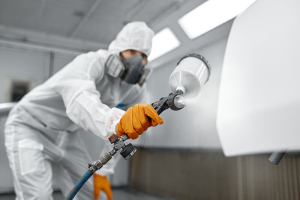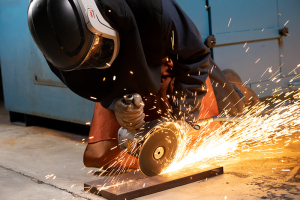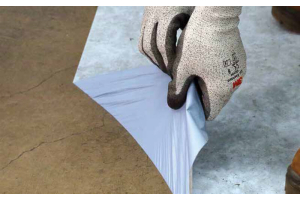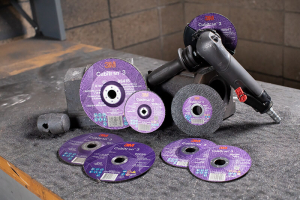M.K. Morse Band Saw Blade Selection
One of the more recent additions to the line here at CW Hayden is M.K. Morse from Canton, Ohio. They manufacture saw blades for all industries including hole saws and cutters, reciprocating and jig saws, round metal cutting blades, and the subject of this piece – band saw blades. They’ve been in the business for over 50 years and are still a family owned company just like ours, and virtually all their products are manufactured in their Ohio headquarters.
There are many variables that come into consideration when you’re choosing the correct band saw blade for your application. If you do not have a hard enough steel the blade will wear out quickly. If you have an incorrect number of teeth per inch it can cause either tooth loss or slow cutting due to load up. If you have too hard a backing it can cause the blade to fracture or if it IS too flexible it can cause the cut to wander. I can’t possibly do justice to every variable or application here in this small letter, but what I can accomplish is to give an overview of the basic styles of band saw blades we have available and explain why each family of blades were developed. This combined with some common sense rules along with our phone number to call and discuss specific application details can get you a decent starting place to order a blade that will perform well in your shop.
Metal Cutting
To begin a search for the perfect metal cutting band saw, you need to start with the steel. You’re using one metal to plough through another metal so the blade obviously has to be harder than what is being cut. My favorite starting blade for general purpose cutting of milder steel, stainless or aluminum is Morse M42. It’s a  durable production blade that excels in “higher speed applications on difficult to machine solids and heavy walled structures” according to their literature. M42 is a great blade for solid round or square stock, I beams, and heavy walled tubing. It has a competitive price point that makes it worth trying for many applications. Try it for thin walled materials too, but be sure to ask for a higher tooth count to keep from snagging or breaking the blade.
durable production blade that excels in “higher speed applications on difficult to machine solids and heavy walled structures” according to their literature. M42 is a great blade for solid round or square stock, I beams, and heavy walled tubing. It has a competitive price point that makes it worth trying for many applications. Try it for thin walled materials too, but be sure to ask for a higher tooth count to keep from snagging or breaking the blade.
If your band saw is smaller and has a little less power, try the Matrix II. It’s designed for thinner materials like tubing or bundles of solid stock where the opportunity for ‘interrupted cut’ is greater. This means the blade may be contacting more than one area of substrate in the cut like you would have in a bundle of tubing or angles, so vibrations can set in causing wander or stutter that stresses the blade more.
If you have a lot of structural applications of carbon steel, low alloy steels, mixed with interrupted cuts again or are just looking for longer life and straighter cuts, you should try the Challenger blade. This blade excels in tougher applications and I’ve found it has great life on stainless. A similar improvement exists with the Morse Achiever blade, that improves performance on a wide range of steels including some tougher to cut stainless grades. The Achiever uses spring steel as a backer for additional rigidity so it cuts more accurately on stacked bundles of heavy solid stocks.
If you have some exotic alloys or lower grades of stainless steels, you might get better performance from an M-Factor blade. There are four choices depending on what you are trying to improve. The EX is for exotic grades, the GP is for general purpose usually in steel service centers or forges, the CH is case hardened for smoother cuts on chrome plated steels, and the FB and FBS are specifically for non-ferrous applications, but there is a furniture maker spec too. Beyond that are the Independence II and EPX blades that ratchet up life in high production shops. They are low tooth count typically thick blades that excel in high grunt applications where you want maximum blade life and aren’t as worried about oddball stuff that might cause breakage.
Morse has a new treatment they are employing in some metal cutting blades that other companies haven’t copied yet. They call it SParc technology which essentially is a very slight arc that repeats on the back edge of the blade. This arcing rides against blade guides causing the blade to rock slightly in the cut much like you might perform using a hacksaw. It’s a very slight rocking, but measurably affects the cut in a positive way speeding up the cut and providing longer life to the blade. This technology isn’t in every Morse metal saw, but is in the M42, Acheiver, and a few others. You may not be able to readily see this back treatment, but it is there alternately increasing the feed pressure and enabling longer ‘in-square’ cutting.
it SParc technology which essentially is a very slight arc that repeats on the back edge of the blade. This arcing rides against blade guides causing the blade to rock slightly in the cut much like you might perform using a hacksaw. It’s a very slight rocking, but measurably affects the cut in a positive way speeding up the cut and providing longer life to the blade. This technology isn’t in every Morse metal saw, but is in the M42, Acheiver, and a few others. You may not be able to readily see this back treatment, but it is there alternately increasing the feed pressure and enabling longer ‘in-square’ cutting.
This article wouldn’t be complete without mentioning the Morse mini-band saw blades too. Available in standard and custom sizes, these little saws are very handy where you might otherwise chew through using a stockade or hacksaw. The beauty of Morse mini’s is the performance you get for very little money. I’ve seen other manufacturers selling imported blades for upwards of $9 per blade, while Morse gives you Made-in-USA blades with variable tooth count for around $4. The performance is excellent either in coarse tooth for heavy materials like heavy pipe and rebar or finer tooth to handle thin materials like conduit or steel studs.
Carbide
The ultimate durability option for wood and composites is carbide tooth blades. These can power through lots of abrasive or difficult to cut materials and miles of wood with the trade-off of a fairly steep cost per blade. There are several specs available depending on substrate and operation. Another type of blade Morse makes is the carbide grit edge blades. These are the correct choice in applications where you are cutting laminates, ceramics, cast iron, graphite, and especially wire rope or brittle materials. Carbide grit is excellent in composite shops like boat builders provided the laminations don’t include any wooden cores. Both continuous edge and gulleted blades are available to provide smooth cuts or faster cutting where chip loading is an issue.
Wood and Composites
Last up are the wood cutting blades. Typically, these have coarser tooth counts, many of these blades are made of simple carbon steel to reduce cost. The alloys are altered to provide greater or lesser flex depending on particular application v ariables – a flexible backing gives more fatigue resistance while hard back blades wander less in the cut. Wood cutting blades start at 1/8” wide for scroll cutting up to 2” wide for more accurate re-sawing. In the pallet dismantling/rebuilding business, there are nails to be dealt with. Nobody pulls these nails, they are sawn through with special jig type bandsaws. These nails would chew up carbon blades the same as hitting the odd nail or bullet in a plank of wood, so in this application we would use a bi-metal blades borrowed from the metal cutting guys. We need to add more teeth per inch than when cutting wood by itself, so the cut is a little slower but it is a cleaner cut and the blades easily saw nails off allowing pallets to be dismantled and rebuilt. For the home hobbyist, one of these bi-metal wood blades is a very real upgrade. I cut lots of wood in my shop and occasionally hit a piece of steel like a nail or staple. This used to mean my blade would now need to be tossed as it would take the set out of one side of the blade causing my cuts to wander, especially when re-sawing. Switching to a bi-metal M42 with 6 hook teeth per inch has reduced the chance for nails to destroy the teeth since it is designed to cut steel all day. Yes, it cuts slightly slower but if I pushed it hard and did hit a nail there is a chance the teeth might straddle the nail and rip a tooth off so I keep the pressure down and the blade lasts much longer. I can now also cut aluminum, brass, and steel which is a bonus. This blade spec is great in composite shops that want to cut fiberglass or graphite panels and also the odd piece of steel or wood too. It’s not optimized for any of those applications, but will reliably make the cuts without damage.
ariables – a flexible backing gives more fatigue resistance while hard back blades wander less in the cut. Wood cutting blades start at 1/8” wide for scroll cutting up to 2” wide for more accurate re-sawing. In the pallet dismantling/rebuilding business, there are nails to be dealt with. Nobody pulls these nails, they are sawn through with special jig type bandsaws. These nails would chew up carbon blades the same as hitting the odd nail or bullet in a plank of wood, so in this application we would use a bi-metal blades borrowed from the metal cutting guys. We need to add more teeth per inch than when cutting wood by itself, so the cut is a little slower but it is a cleaner cut and the blades easily saw nails off allowing pallets to be dismantled and rebuilt. For the home hobbyist, one of these bi-metal wood blades is a very real upgrade. I cut lots of wood in my shop and occasionally hit a piece of steel like a nail or staple. This used to mean my blade would now need to be tossed as it would take the set out of one side of the blade causing my cuts to wander, especially when re-sawing. Switching to a bi-metal M42 with 6 hook teeth per inch has reduced the chance for nails to destroy the teeth since it is designed to cut steel all day. Yes, it cuts slightly slower but if I pushed it hard and did hit a nail there is a chance the teeth might straddle the nail and rip a tooth off so I keep the pressure down and the blade lasts much longer. I can now also cut aluminum, brass, and steel which is a bonus. This blade spec is great in composite shops that want to cut fiberglass or graphite panels and also the odd piece of steel or wood too. It’s not optimized for any of those applications, but will reliably make the cuts without damage.
Call us with your challenging application, we can put you in touch with the technical support reps in Ohio who have years of experience helping end users just like you!
You can also visit us online at www.cwhaydenonline.com/mkmorse








